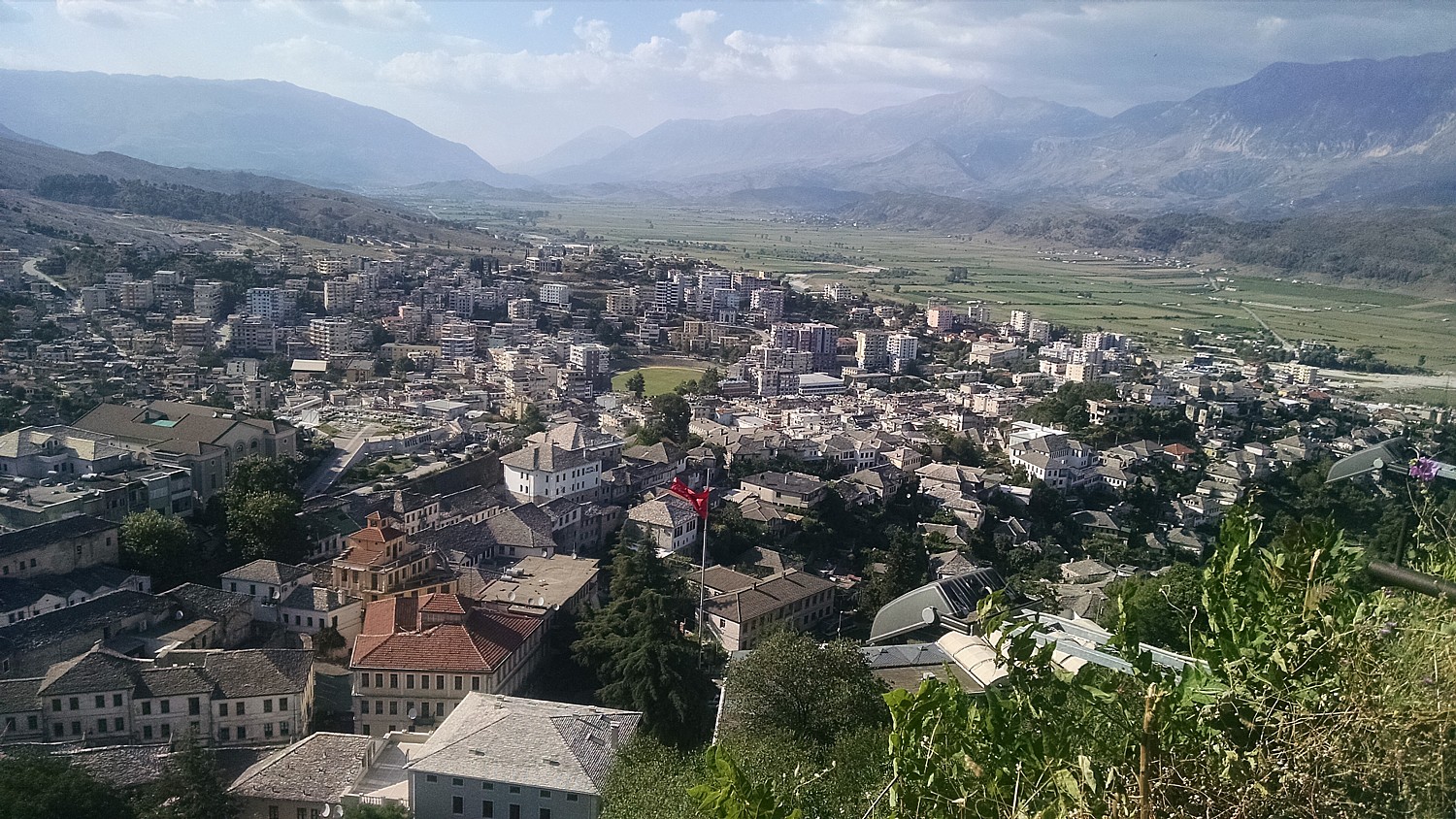
By Karen Rubin, goingplacesfarandnear.com
(I travel to Albania with BikeTours.com’s President Jim Johnson on a specially constructed “President’s Tour” itinerary that modifies the regular “Albania’s UNESCO Sites with Rivers, Valleys, and Gorges” trip. (See: Come to Albania Now to See Emergence of a Young Country-Best Way to Experience Albania is on Bike Tour. This is 5th in the series.)
Our ride today, the 6th of cycling (7th of the tour), will bring us into the historic city of Gjirokaster – an Ottoman-era city carved into the hillside overlooking a spectacular river valley.
Today’s 46 km ride is one of the easiest – almost steadily downhill or flat – for a total elevation gain of just 200 meters and a loss of 360 meters. We follow the Vjoca River to Kelcyra Gorge.
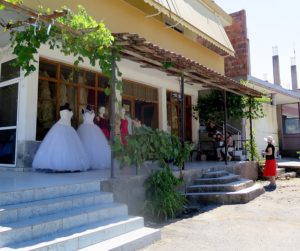
We stop on the road in a small village (I note the bridal shop) and Junid, our guide on this biking journey across the southern part of Albania, picks up ice cream for 50 Leke (that’s about 50 cents for an ice cream that would be $2.50 in the US) and we fill our water bottles by a natural spring – fresh and cool.
Our lunch is in a delightful restaurant which literally has a stream running over it, like a waterfall. We sit upstairs on a terrace, and the water runs down as we eat, making it look like a sunshower.
After a most delightful lunch, we drive in the van 24 km along a highway and then up a steep, twisting road into the old city of Gjirokaster (also spelled Gjirokastra or Girocastro) built on a hill 300 meters high, overlooking a lush valley beside the mountains Mali Gjerë and the Drinos river.
This means we only biked 46 km instead of 70 km, but that saves our legs and lungs (which would have been brutal to go up the hill to the village). The biking trip is not designed to be a brutal test of endurance; it is designed so that we can really enjoy the scenery and get a sense of place. So driving us into Gjirokaster also gives us more time (and energy) to explore “the city of 1000 steps”, with its narrow cobblestone streets, that is dominated by a formidable castle.
Gjirokaster
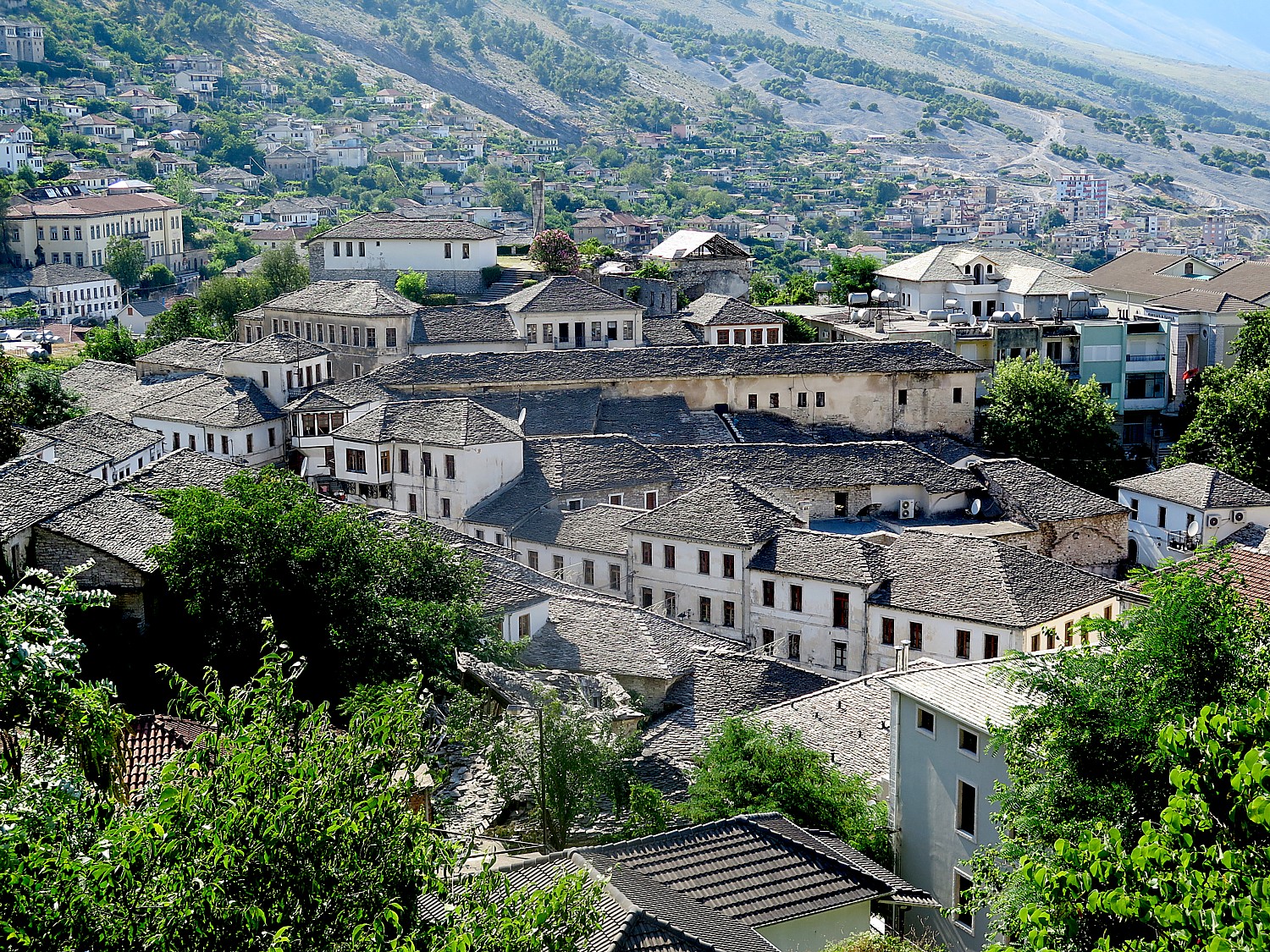
I quickly drop my things at the Hotel Cajupi, right below the Castle which looms from above, and go off to explore on my own before we are scheduled to meet for Junid to take us on a walking tour.
Gjirokaster is one of the oldest cities of Albania, its name means Silver Fortress and the city clearly shows the confluence of Greek, Roman, Turkish and Albanian cultures. The historic district is a protected UNESCO World Heritage Site.
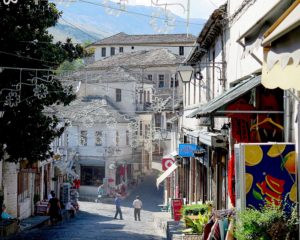
Gjirokaster is a very popular tourist attraction (they are cultivating cultural tourism) and it is understandable why we see (wonderful) souvenir shops, English signs, historic markers with English translation, a fantastic tourist map. In fact, these are the best (actually only) tourist shops we encounter on our trip. That’s not because of American tourists, who are scant in number (though I do come upon a few), but because of Scandinavians, Swiss, Germans and Poles who come for whom English is the most common language.
I explore a bit on my own and enjoy discovering the 18-19th century houses with their distinct architectural features.
The “city of a thousand steps” which is also known as the “city of stone” is distinguished by hundreds of Ottoman-style tower houses with distinctive shapes, stone roofs, wooden balconies and whitewashed stone walls.
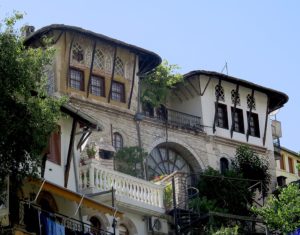
Gjirokaster has gone “from feudal stronghold to Ottoman jewel to Italian colony, the city has known many rulers and has inspired poets, authors and artists,” Europa Travel & Tours, an Albanian travel company, notes.
The network of cobblestone streets climb steeply out of a bazaar at the center of the old town. You walk ever higher to the 13th century castle.
The village is perched on the steep side of the Drino Valley overlooking a stunning landscape framed by snow-capped mountains.
In 1336, the city was known by its Greek name, Argyrokastro and was part of the Byzantine Empire. It later became the center of the local principality under the Albanian lord, Gjon Zenebishi before falling under Ottoman Empire rule for the next five centuries. It was occupied by the Greek Army during the Balkan Wars because of its large Greek population (street signs are in both Albanian and Greek and the Greek minority still speaks Greek instead of Albanian). It was eventually incorporated into Albania in 1913, when Albania won its independence from the Ottoman Empire, and the Council of Ambassadors (Western powers) put the area within its borders.
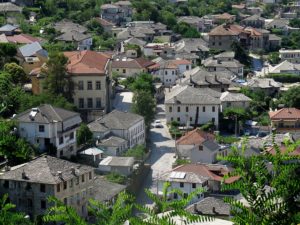
Gjirokaster owes its preservation to the fact it is the birthplace of the former Albanian Communist dictator Enver Hoxha, who ordered that the city remain untouched (except for destroying the mosques; the city, Junid says, once had 15 mosques but today has only one). It has been under UNESCO protection since 2005.
This is a city that honors three important writers including Ismail Kadare, most famous for “Chronicle in Stone” which is set in Gjirokaster, tells the history of the city during the Italian and Greek occupation in World War I and II. Kadare, who lives between Paris and Albania, was nominated five times for the Nobel Prize in Literature and was awarded a gold medal from French President Hollande. You can visit his house in Gjirokaster.
Gjirokaster Castle
Gjrokaster has an abundance of fascinating attractions but the two standouts are the oldest, grandest house, and the Castle that lords over the town and the valley below.

According to some notes I am able to find, the castle dates back to the 12th century, the earliest parts built by the Despots of Epirus, an off-shoot of the Byzantine government. It was reconstructed and adapted to modern war techniques during the reign of Ali Pasha of Tepelene, 1812-1821. The magnificent clock tower and an aqueduct were added in the 1800s. But it was Zog, the self-proclaimed King of the Albanians, who, in the 1920s, converted the fortress into a garrison and political prison. Zog also forged an alliance with Mussolini, who provided funds to Albania to modernize its army, but, in 1930, sent 30,000 Italian soldiers to occupy Albania.
As Junid relates, Mussolini modernized Albania’s army believing that Albania would provide a barrier for Italy’s own defense. “But then the King made a new connection with Mussolini’s enemy – so Mussolini invaded and occupied and used castle for defense,” Junid tells us. He says that there would have been as many as 5000 soldiers living in the castle (hard to imagine).
It was operated as a prison until 1968 when the castle was turned into a military museum paying tribute to Albanian independence.

Inside the stone walls, we find World War I and World War II Italian tanks and cannon (including a tiny Panzer with a Fiat engine) on display. Outside, there is a US fighter plane that they claim was a spy plane that was shot down (actually the plane had crashed landed near Tirana) and is shown off as a kind of trophy.
From this perch, we gaze out to a spectacular view of the valley. Greece is very close by; indeed, until 1914, this area was part of Greece, but was assigned to Albania by the Council of Ambassadors (the Western European powers). There is still a large Greek minority near here – signs are in both Greek and Albanian, the TV is Greek, and there are Albanians in the area who only speak Greek.
The castle is also the venue for the Balkan Festival, held every five years, a music and cultural festival involving some 30 countries.
(Admission to the castle is 200 Leke, or about $2).
Skendulate House
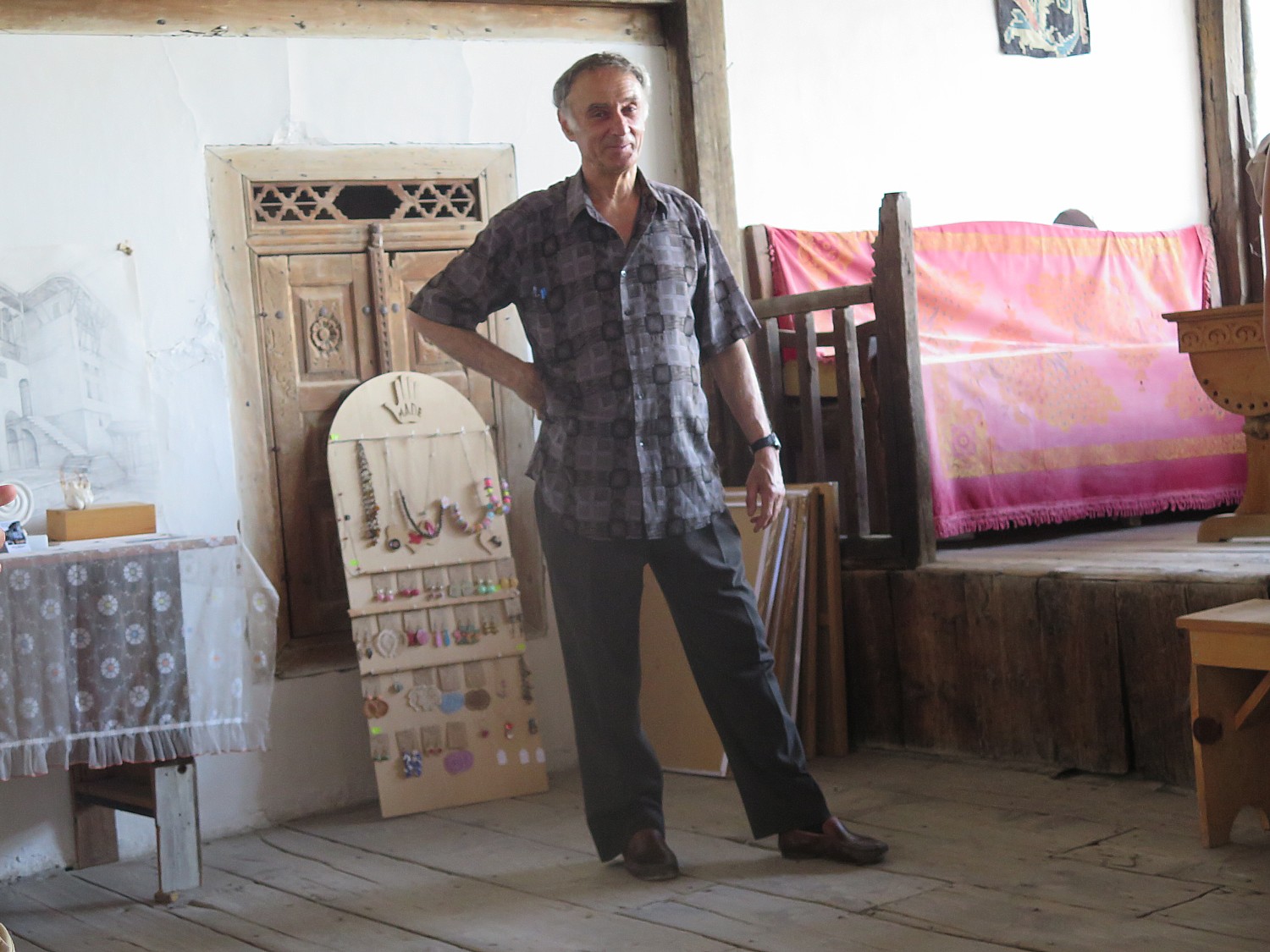
A second attraction we visit, the Skendulate House, is spectacular in its own way because it provides a human connection to quite literally centuries of history.
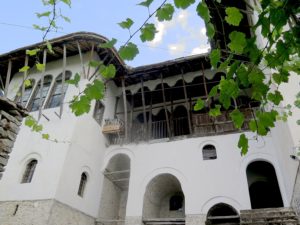
As luck would have it, we are escorted around the house by the 9th generation owner, the last to occupy the house before it was taken over by the Communists and turned into an “enthnographic” museum (and after Communism fell, tried to block the owner from filing his claim of title, offering a pittance, the equivalent of a few hundred dollars, to maintain it as a national museum.)
Before Communism, a feudal system prevailed and a handful of rich families owned the land. Then the Communist regime nationalized all the property and took over the house.
Since the fall of Communism, in 1992, property ownership was restored, but there are still unresolved issues about who actually owns the land: The original feudal families? The workers who labored on the land. Until ownership is resolved, investment and development has simply ceased – as we travel around the country, we see numerous buildings left unfinished – the owners purposely started building in order to establish their claim.
This grand house of Skendulate dates from 1833 (according to one document I see; he says it dates from the 17th century, which could mean that his family owned the property from then). He is the 9th generation and the last to live in the house before it was nationalized by the Communist regime and turned into an ethnographic museum.
You get an idea of what the conditions were like when this great house – which would have been one of the richest and most splendid in the region (though he says it wasn’t the richest or most splendid) – was built. Junid translates as he points out 10 openings to protect the house; there would have been 10 guards to control the courtyard; two entrances (one for people and the other for animals). It has 64 windows, 44 doors, a cellar to preserve food for winter, a cistern to store water captured from the rain. He points out how the house was built with layers of natural chestnut wood, because it would be flexible.
The house had a bunker “in case of war or barbarity” and was constructed with two cupolas – so that cannon fire would hang from the first cupola and not penetrate deeper.
The house was built with a cellar for natural refrigeration (milk could be kept fresh for 3-4 days), they captured rainwater and had a water cistern that held 130 cubic meters of water so they could be pretty much self-sufficient for a period of time.
The house was built for cooler rooms in summer and warmer rooms for winter with a wood fireplace. It had six indoor bathrooms (the waste was pumped out) and 9 fireplaces (the more fireplaces, the greater the wealth). There would have been 20 people – 3-5 families – living in the house at one time.
The house was constructed so that men and women were kept separate.
In one room where men would gather, women could look down and count the men in order to know how much coffee and Rakia (a liquor) to prepare and serve, giving it to a male who would serve the rest.
We visit the kitchens where children and women would eat first, then the men; and poke into the various bedrooms one by one (the grandmother’s room was the smallest).
The family lived in the house until 1981, when the Communist regime turned it into an Ethnographic Museum.
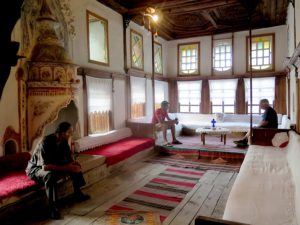
The family got the house back in 1993 (as well as their landholdings), after a year of filing claims and the state trying to keep it as a museum. But it was unlivable (in fact, it would not be allowed to be opened to the public in the US in its condition), so he has continued showing it as a private, cultural museum.
It is odd to sit in the grandest room, lined with banquettes. He says it is the room where weddings would be held – in fact, it was the very room where he was married.
The decoration of the woodwork, the ceiling, the painted fireplace, is magnificent. The fireplace is painted with pomegranates – a symbol of his family.
He says that the only time a bride would be in the same room as men is at her wedding. It would be an arranged marriage, performed by the family.
There would be two days of receptions – one day for the bride’s family (Saturday), Sunday for the groom’s family. Women would look down through a screen from a mezzanine. “They might see their future husband” among the gathering.
He seems to get wistful as he relates that his was the last generation to live in the house; he had lived here for 33 years, was married in this very room, but, his son was 3 years old, they all were kicked out when the Communists took it over. (200 Leke entry fee, about $2).
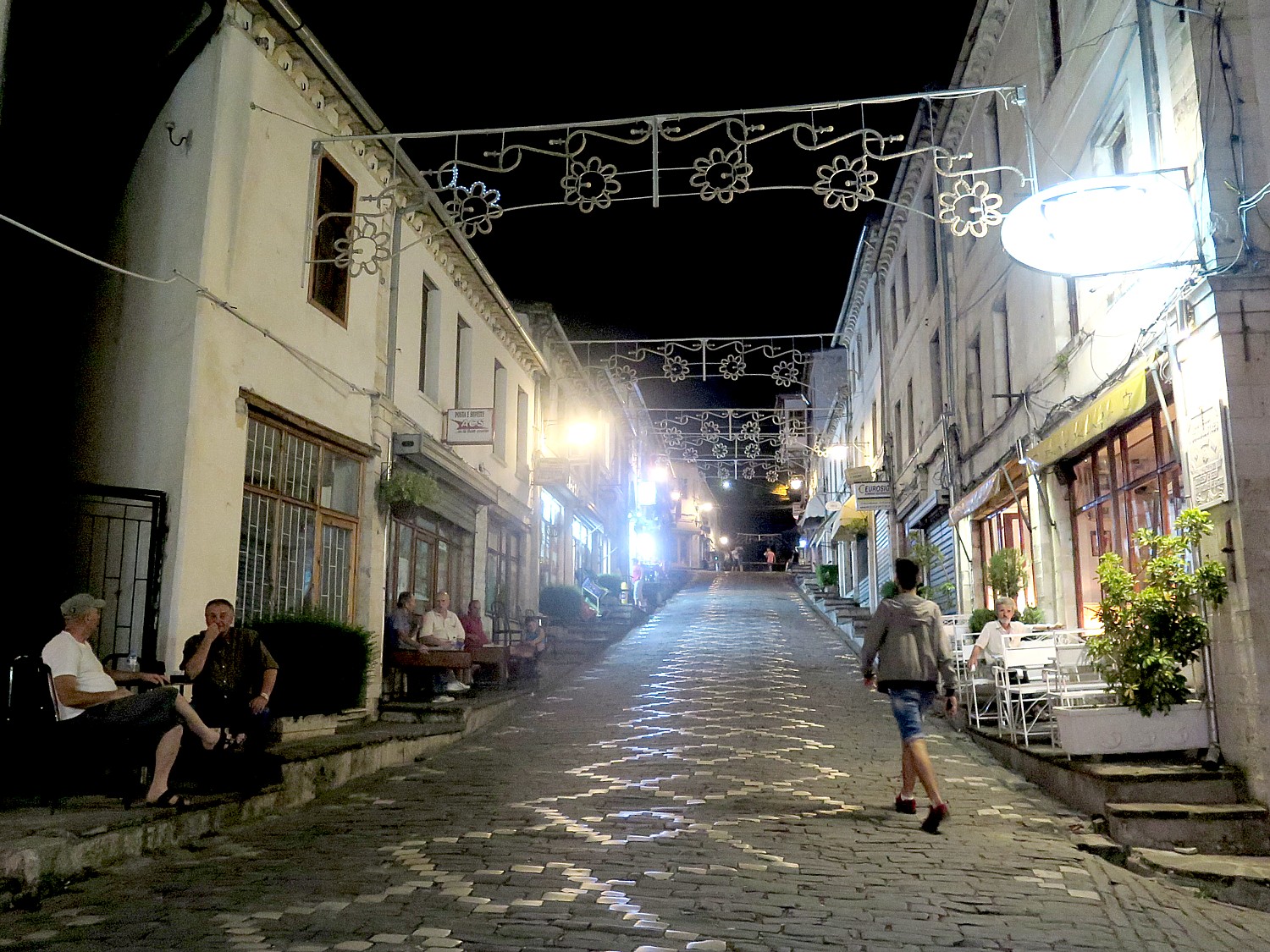
There are many other attractions of Gjirokaster, most that can be appreciated just by walking around. You can also visit Ismail Kadare’s house, historic houses such as Zekate House (1812), Angone, Babameto and Kabilate. the Ethnographic Museum. Besides the buildings in Ottoman style, there are several stunning buildings in the historic district in 19th century Italian style, like the hotel “Royal”, the former “Banco di Napoli”, the former shopping center Ziga, the High School (labeled the “gymnasium”), Villa “Kokalari” and Villa “Papavangjeli”.
There’s also an intriguingly named The Cold War Tunnel, which Junid dismisses and I don’t have time to discover on my own.
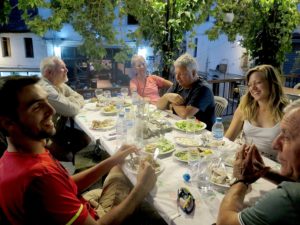
We get a little time to shop (this is the only place we find where there are actually shops to buy crafts and such, and meet up at a delightful restaurant for dinner, where I watch as entire lambs are roasted on a spit.
We then go off to a tavern in the square just outside our hotel, where big-screen TVs are outside, and people have gathered to watch the European football (soccer) matches.
There are still some scheduled departures left this year for “Albania’s UNESCO Sites with Rivers, Valleys, and Gorges,” 9 nights, Level 4, averaging 37 miles/day (950E or about $1050) (www.biketours.com/albania/albania-UNESCO-tour).
BikeTours.com 1-877-462-2423 or 423-756-8907, 1222 Tremont St., Suite 100, Chattanooga, TN 37405, biketours.com.
See also:
Biking Albania: Exploring Heritage Sites of Lake Ohrid, St Naum, Ancient City of Ohrid
Biking through Albania’s ‘Breadbasket’ into Korca, the ‘Paris of Albania’
Biking Albania: Farm, Thermal Springs on Route through Countryside into the Mountains
Next: Biking Albania: Greco-Roman City of Butrint
____________________
© 2016 Travel Features Syndicate, a division of Workstyles, Inc. All rights reserved. Visit goingplacesfarandnear.com and travelwritersmagazine.com/TravelFeaturesSyndicate/. Blogging at goingplacesnearandfar.wordpress.com and moralcompasstravel.info. Send comments or questions to FamTravLtr@aol.com. Tweet @TravelFeatures. ‘Like’ us at facebook.com/NewsPhotoFeatures
